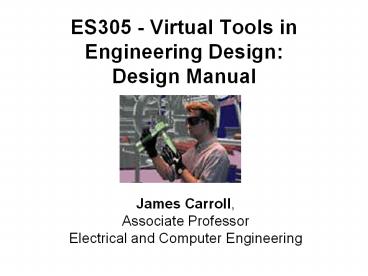ES305 - Virtual Tools in Engineering Design: Design Manual - PowerPoint PPT Presentation
Title:
ES305 - Virtual Tools in Engineering Design: Design Manual
Description:
ES305 - Virtual Tools in Engineering Design: Design Manual James Carroll, Associate Professor Electrical and Computer Engineering About Eng. Design Teams Consist of ... – PowerPoint PPT presentation
Number of Views:187
Avg rating:3.0/5.0
Title: ES305 - Virtual Tools in Engineering Design: Design Manual
1
ES305 - Virtual Tools in Engineering Design
Design Manual
- James Carroll,
- Associate Professor
- Electrical and Computer Engineering
2
About Eng. Design Teams
- Consist of Members with a Mix of Backgrounds and
Training - Scientists Have strong training in math and
science which emphasizes the theoretical.
Scientists ask "Why?" questions.
3
About Eng. Design Teams
- Engineers Attempt to do something useful with
scientific theories and principles, called
design, i.e., a creative process that produces in
a new device, system, structure, or process that
satisfies a specific need. - Technologists Do much of the actual
implementation of the engineering designs, like
CAD drawings, testing, data taking and reduction,
and directing craftspeople during fabrication. - Craftspeople Are the practical or implementation
end of the spectrum. They primarily manufacture
or assemble the products designed by the rest of
the team, e.g., welders, machinists, etc.
4
The Design Process
5
The Design Process
6
Detailed Design Process w/Iteration
7
Detailed Design Process w/Iteration
8
Detailed Design Process w/Iteration
9
Detailed Design Process w/Iteration
10
The Problem Statement and Functional Requirements
11
Brainstorming
12
Brainstorming Rules
13
Sketchstorming
14
Be Creative and Think Laterally!
15
Be Creative and Think Laterally!
16
Identifying and Evaluating Design Alternatives
An Example
17
(No Transcript)
18
Identifying and Evaluating Design Alternatives
An Example
19
Identifying Design AlternativesWeighted
Objective Trees
20
(No Transcript)
21
(No Transcript)
22
Developing Models and Prototypes
- All modeling can be broken down into one of two
categories - Descriptive Models Depict ideas, products, and
processes in a way that is recognizable. The
goal is to show what a design would look like if
it were created. - Examples Engineering drawings, 3D computer
models, or scale models - Predictive Models Used to test and understand
how designs ideas, products, and processes will
perform. May bear little or no resemblance to
the overall design. - Examples Mathematical equations or graphs
showing a relationship between design requirements
23
Developing Models and Prototypes
- Scale models are one of the most basic and
generally useful because they are very much
hands-on and provide a good feel for a design and
its features - Computer simulation and animation are two other
common model types
24
Common Engineering Analyses
25
Common Engineering Analyses
26
Thoughts on Project Management
27
Do Not Leave Team Development to Chance!
28
Keeping on Schedule
29
Four Stages of Team Development
30
Four Stages of Team Development
31
Four Stages of Team Development
32
Four Stages of Team Development
33
Four Stages of Team Development
34
References
- S. Pugh, Total Design , Addison-Wesley, 1991.
ISBN 0-201-41639-5 - M.N. Horenstein, Engineering Design, Prentice
Hall, 1999. ISBN 0-13-085089-6 - L.J. Kamm, Real-World Engineering, IEEE Press,
1991. ISBN 0-87942-279-3 - J.P. Lewis, Fundamentals of Project Management,
American Management Association, 1995. ISBN
0-8144-7835-2 - JC. Martin, The Successful Engineer, McGraw-Hill,
1993. ISBN 0-07-040725-8































